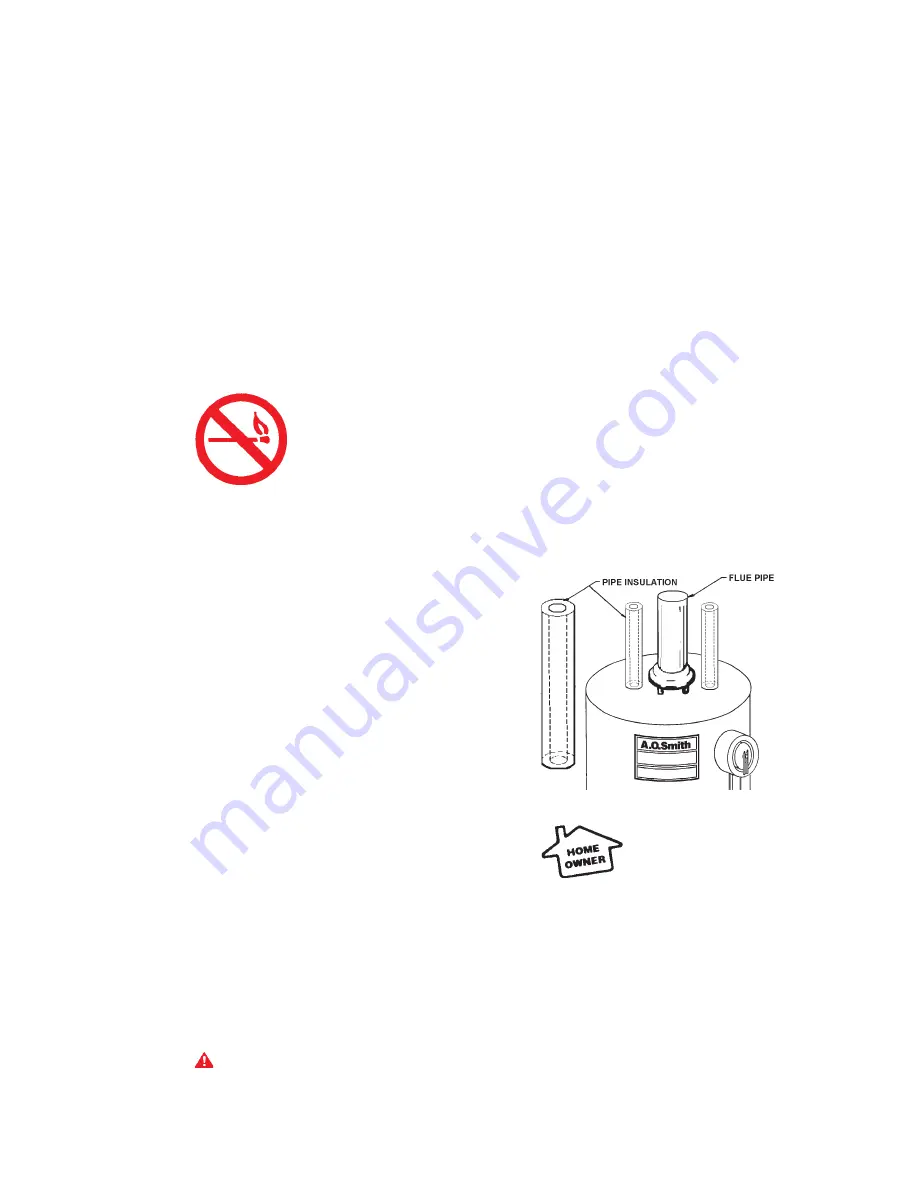
6
recommendations of serving gas supplier. Refer to the latest
edition of ANSI Z223.1.
To prevent damage, care must be taken not to apply too much
torque when attaching gas supply pipe to thermostat gas inlet.
The thermostat inlet has a pad for use with a backup wrench.
Apply joint compounds (pipe dope) sparingly and only to the
male threads of pipe joints. Do not apply compound to the first
two threads. Use compounds resistant to the action of liquefied
petroleum gases. Do not use teflon tape on thermostat fittings.
DISCONNECT THE APPLIANCE AND ITS INDIVIDUAL SHUT
OFF VALVE FROM THE GAS SUPPLY PIPING SYSTEM DURING
ANY SUPPLY PRESSURE TESTING EXCEEDING 1/2 PSI
(3.5 kPa). GAS SUPPLY LINE MUST BE CAPPED WHEN
DISCONNECTED FROM THE HEATER. FOR TEST
PRESSURES AT 1/2 PSI (3.5 kPa) OR LESS, THE APPLIANCE
NEED NOT BE DISCONNECTED, BUT MUST BE ISOLATED
FROM THE SUPPLY PRESSURE TEST BY CLOSING THE MAIN
MANUAL GAS VALVE.
BEFORE PLACING THE HEATER IN OPERATION, CHECK FOR
GAS LEAKAGE. USE SOAP AND WATER SOLUTION OR OTHER
MATERIAL ACCEPTABLE FOR THIS PURPOSE. DO NOT USE
MATCHES, CANDLES, FLAME OR OTHER SOURCES OF
IGNITION TO LOCATE GAS LEAKS.
DRAFT HOOD
THE DRAFT HOOD INCLUDED WITH THE HEATER MUST BE
INSTALLED PROPERLY FOR SAFE OPERATION.
Locate draft hood as seen in figure 1. Position draft hood over
the flue tube. Align the draft hood legs with the four holes
surrounding the flue. Insert tabbed end of legs into the
corresponding holes and twist to lock the draft hood in place.
When installing vent piping, secure the vent pipe to the draft
hood using at least three sheet metal screws in the draft hood
outlet.
VENTING
THE HEATER WITH DRAFT HOOD INSTALLED AS SHOWN IN
FIG. 1 MUST BE CONNECTED TO A CHIMNEY OR GAS VENT.
The vent pipe from the heater to the chimney must not be smaller
than the outlet of the draft hood on the heater and should slope
upward to the chimney at least 1/4 inch per foot. Do not extend
vent pipe beyond the inside wall of the chimney.
For proper venting in certain installations, a field installed
increased size vent connector and pipe size may be needed.
Consult vent tables in the latest edition of the National Fuel Gas
Code ANSI Z 223.1
WARNING
NEVER OPERATE THE HEATER UNLESS IT IS VENTED TO
THE OUTDOORS AND HAS ADEQUATE AIR SUPPLY TO AVOID
RISKS OF IMPROPER OPERATION, FIRE, EXPLOSION OR
ASPHYXIATION.
RELIEF VALVE - FIG. 1
A NEW TEMPERATURE AND PRESSURE RELIEF VALVE
COMPLYING WITH THE STANDARD FOR RELIEF VALVES AND
AUTOMATIC GAS SHUT OFF DEVICES FOR HOT WATER
SUPPLY SYSTEMS, ANSI Z21.22 (LATEST EDITION) MUST BE
INSTALLED IN THE HEATER IN THE MARKED OPENING
PROVIDED. THE VALVE MUST BE OF A SIZE (INPUT RATING)
THAT WILL BE ADEQUATE FOR YOUR SIZE HEATER.
Check the metal tag on the relief valve and compare it to the
heater’s rating plate. The pressure rating of the relief valve
must not exceed the working pressure shown on the rating
plate of the heater. In addition, the hourly Btu rated temperature
steam discharge capacity of the relief valve shall not be less
than the input rating of the heater.
NO VALVE IS TO BE PLACED
BETWEEN THE RELIEF VALVE AND TANK. DO NOT PLUG
THE RELIEF VALVE.
The drain line connected to this valve must not contain a reducing
coupling or other restriction and must terminate near a suitable
drain to prevent water damage during valve operation. The
discharge line shall be installed in a manner to allow complete
drainage of both the valve and line.
DO NOT THREAD, PLUG
OR CAP THE END OF THE DRAIN LINE.
PIPE INSULATION - INSTALLATION
(SELECTED MODELS)
1. Remove pipe insulation from carton.
2. Fit pipe insulation over the incoming cold water line and
the hot water line. Make sure that the insulation is against
top cover of heater.
FIGURE 3
OPERATION
NEVER OPERATE THE HEATER WITHOUT FIRST BEING
CERTAIN IT IS FILLED WITH WATER AND A TEMPERATURE
AND PRESSURE RELIEF VALVE IS INSTALLED IN THE RELIEF
VALVE OPENING OF THE HEATER. DO NOT ATTEMPT TO
OPERATE HEATER WITH COLD WATER INLET VALVE CLOSED.
FILLING
1. Close the heater drain valve by turning handle clockwise,
Fig. 1.
2. Open a nearby hot water faucet to permit the air in the system
to escape.
3. Fully open the cold water inlet pipe valve allowing the heater
and piping to be filled, Fig. 1.
4. Close the hot water faucet as water starts to flow.
5. The heater is ready to be operated.






























